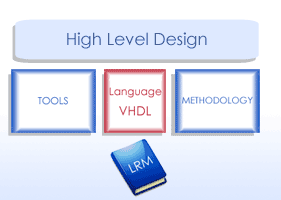
VHDL is the VHSIC Hardware Description Language. VHSIC is an abbreviation for Very High Speed Integrated Circuit. It can describe the behaviour and structure of electronic systems, but is particularly suited as a language to describe the structure and behaviour of digital electronic hardware designs, such as ASICs and FPGAs as well as conventional digital circuits.
VHDL is a notation, and is precisely and completely defined by the Language Reference Manual (LRM). This sets VHDL apart from other hardware description languages, which are to some extent defined in an ad hoc way by the behaviour of tools that use them. VHDL is an international standard, regulated by the IEEE. The definition of the language is non-proprietary.
VHDL is not an information model, a database schema, a simulator, a toolset or a methodology! However, a methodology and a toolset are essential for the effective use of VHDL.
Simulation and synthesis are the two main kinds of tools which operate on the VHDL language. The Language Reference Manual does not define a simulator, but unambiguously defines what each simulator must do with each part of the language.
VHDL does not constrain the user to one style of description. VHDL allows designs to be described using any methodology - top down, bottom up or middle out! VHDL can be used to describe hardware at the gate level or in a more abstract way. Successful high level design requires a language, a tool set and a suitable methodology. VHDL is the language, you choose the tools, and the methodology... well, I guess that's where Doulos come in to the equation!

Next
Your e-mail comments are welcome - send email
Copyright 1995-2002 Doulos




